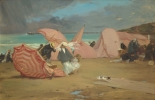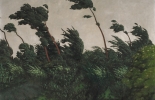The wind. “that which cannot be painted”
from June 25 to October 02, 2022
Since time immemorial, the wind has presented humankind with a challenge. How can you depict something that is invisible? This exhibition explores the means by which visual artists have tried to solve this conundrum and illustrates how depictions of the wind have evolved through the ages, as our understanding of the wind as a phenomenon has improved.
The invention of cinema, which made it possible to show movement over time, was crucial. Before that, the wind could only be depicted by means of a still image.
The exhibition itinerary features 170 artworks - paintings, drawings, prints, photographs, videos, glassware, etc. - by over 100 artists from classical times to the present day, including Dürer, Goya, Pierre-Henri de Valenciennes, Hiroshige, Hokusaï, Baron Gérard, Turner, Corot, Hugo, Daumier, Millet, Nadar, Boudin, Daum, Monet, Renoir, Gallé, Steinlen, Anquetin, the Lumière brothers, Sorolla, Vallotton, Vlaminck, van Dongen, Raoul Dufy, Arp, Man Ray, Lartigue, Buster Keaton, Brassaï, Gilbert Garcin, Alexandre Hollan, Bernard Moninot, Corinne Mercadier, Philippe Favier, Éric Bourret and Jean-Baptiste Née, ...
The invention of cinema, which made it possible to show movement over time, was crucial. Before that, the wind could only be depicted by means of a still image.
The exhibition itinerary features 170 artworks - paintings, drawings, prints, photographs, videos, glassware, etc. - by over 100 artists from classical times to the present day, including Dürer, Goya, Pierre-Henri de Valenciennes, Hiroshige, Hokusaï, Baron Gérard, Turner, Corot, Hugo, Daumier, Millet, Nadar, Boudin, Daum, Monet, Renoir, Gallé, Steinlen, Anquetin, the Lumière brothers, Sorolla, Vallotton, Vlaminck, van Dongen, Raoul Dufy, Arp, Man Ray, Lartigue, Buster Keaton, Brassaï, Gilbert Garcin, Alexandre Hollan, Bernard Moninot, Corinne Mercadier, Philippe Favier, Éric Bourret and Jean-Baptiste Née, ...
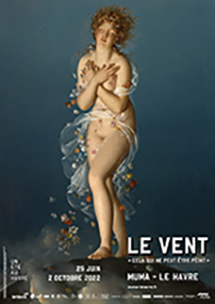
Exhibition Curators
Annette Haudiquet, Director of MuMa
Jacqueline Salmon, photographer
Jean-Christian Fleury, art critic


A follow-up exhibition consisting mainly of contemporary artworks, entitled Météores (Weather), which will take place from 19 November 2022 to 5 March 2023.
EMBODIMENTS OF THE WIND
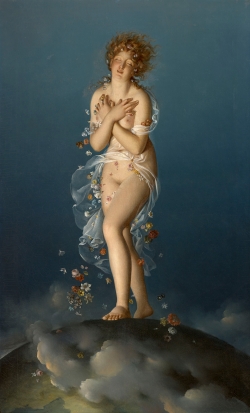
François GÉRARD, Flore caressée par Zéphyr, 1802, oil on canvas, 169 x 105 cm. . © Ville de Grenoble/Musée de Grenoble- J.L. Lacroix
The wind is embodied by deities in human form. For Alain Corbin, the imaginary conception of the winds based on wind-gods in Greek and Roman mythology and the narratives that stem from it, such as the Odyssey, and later on the Bible, endeavoured to make up for their inexplicability.
The exhibition will explore early responses by artists to the challenge of representing the wind through narrative and personification, which lasted well beyond classical times and the Renaissance and featured characters such as Aeolus, Boreas and Zephyrus, Ulysses battling with adverse winds, and the four Angels of the Apocalypse.
HOW TO PAINT THE WIND?
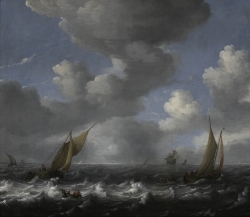
Ludolf BACKHUYSEN (1630-1708), Seascape, 2nde moitié du XVIIe siècle, oil on canvas, 84.5 x 97.3 cm. . © MuMa Le Havre / Florian Kleinefenn
In the early sixteenth century, Leonardo da Vinci wrote several founding texts about air, storms, the wind, the flight of birds and so on. “The wind itself is not visible,” he wrote. “In the air, we see not the movement of the wind but that of the things it carries away, and only these are visible.” Short essays such as “How to paint the wind” and “How to depict tempests” offered painters practical advice. The question of how to depict the wind is approached via description: the blowing of the wind can only be perceived through its effects. Everything moveable - vegetation, especially trees, raging waves, the angle of boats’ masts, figures battling the wind, and clothing - shows the unseen presence of the wind, sometimes frenzied gusts (there are countless references to “blasts of wind”), sometimes a light, caressing breeze, sometimes a Creator who brings sails and linen to life. These treatises set out rules for depicting the wind that were followed for at least three centuries.
THE EPITOME OF ROMANTIC PAINTING
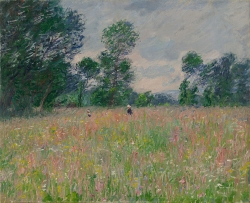
Claude MONET (1840-1926), La Prairie fleurie, 1885, oil on canvas, 65 x 80.5 cm. . © Droits réservés
A WORLD IN MOVEMENT AND A HOMELIER WIND
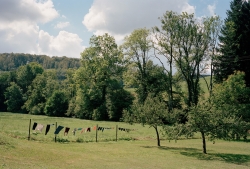
Thibaut CUISSET (1958-2017), Grand Est. Haut-Rhin, région du Sundgau, Dannemarie (Série des Campagnes françaises), 2016, , 64 x 86 cm. . © ADAGP, Paris 2022
IMAGES FROM THE FLOATING WORLD
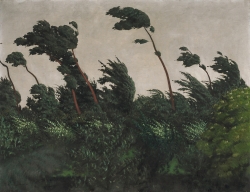
Félix VALLOTTON (1865-1925), Le Vent, 1910, oil on canvas, 89.2 x 116.2 cm. . © Courtesy National Gallery of Art, Washington
CINEMA CAPTURES THE WIND
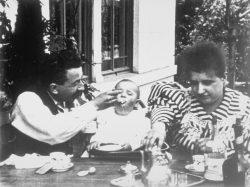
Louis LUMIERE (1864-1948), Le Repas de bébé, 1895, . © Institut Lumière
The wind began to feature in cinema footage as early as 1895. In fact, it is so prevalent that it seems to express the substance of the medium. “The wind and cinema... are both absolute movement” writes Benjamin Thomas, emphasizing that “the apparatus that was heir to the study of movement was bound to aspire to the spellbinding beauty of the free variations of the elements” and that “‘becoming wind’allowed [the cinema] to reveal itself completely and instantaneously as the pure, formless movement it was.”
THE WIND IN CONTEMPORARY ART
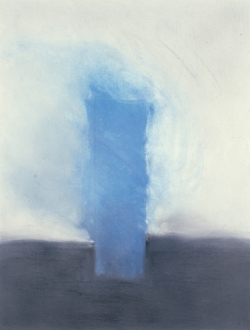
Patrick DAMIOLINI, Hommage au vent, 1983, , 64 x 49 cm. . © Patrick Damiolini / Pascal Victor
MuMa - an ideal setting for an exhibition about the wind
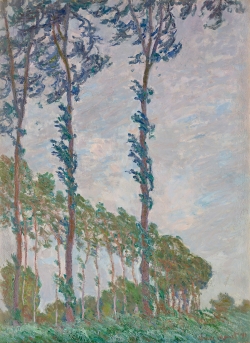
Claude MONET (1840-1926), Effet de vent, série des Peupliers, 1891, oil on canvas, 100 x 74 cm. Paris, musée d’Orsay. © RMN-GP (Musée d’Orsay) / Adrien Didierjean
The museum’s exhibition programming is partly guided by its collections and the highly novel attention paid to their relationship with the setting. Following on from the previous exhibitions “Waves”, The clouds over there… the wonderful clouds and Impression (s): Sun, this summer, MuMa presents “The Wind. ‘That which cannot be painted.’”, an exhibition about a weather phenomenon whose real effects visitors can observe from behind the glass of the museum’s windows in all their varying strengths, at the same time as taking the opportunity to examine their depictions in the pictures by artists such as Boudin, Courbet and Renoir hanging in its galleries.
“Scholars began to understand the wind during the nineteenth century. Until then, this sonorous emptiness was merely experienced and described via the set of feelings it induced. Inconsistency, instability and evanescence defined this invisible, continuous, unpredictable flux. Because of the wind’s fleeting quality and the vastness it conveyed, people did not really know where it came from or where it went,” writes Alain Corbin.
From the beginning, the wind has been all around us, subjecting us to its power and terrifying rages and offering us its benefits. And from the beginning, humankind has wondered how to conceptualize and depict this familiar yet elusive element. Like air, the wind is invisible. We can feel it, but we perceive it only through the effects it has on the visible world. Even as it shapes and deforms the landscape, the wind continues to elude our sight.
This major exhibition asks how the wind can be painted - how something that is by its very nature invisible can be depicted. It encompasses artworks from a wide range of disciplines - painting, drawing, printmaking, archaeology, photography, glassblowing, sculpture, cinema and video - spanning the whole of history in a way that illustrates the continuing fascination of the challenge to depict what cannot be seen and the poetic power of the wind.
MORE +
Publications
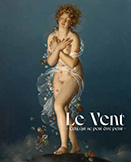
Catalogue d’exposition
MuMa musée d’art moderne André Malraux, Le Havre, 25 juin - 2 octobre 2022
Auteurs : Pascale Dubus, Jean-Christian Fleury, Annette Haudiquet, Daniel Kunth, François-René Martin, Jacqueline Salmon, Benjamin Thomas, Gilles A. Tiberghien
Édition : Éditions Octopus / MuMa Le Havre, 256 pages, 190 illustrations, 35 €, Couverture cartonnée
ISBN : 978-2-900314-32-6


